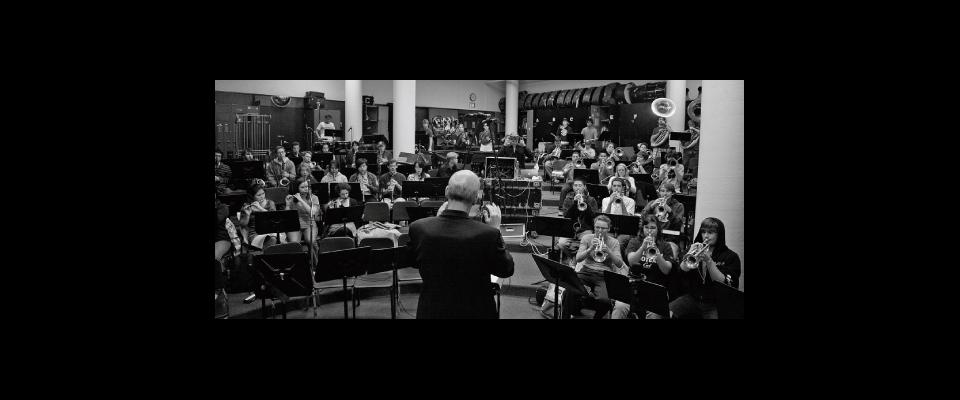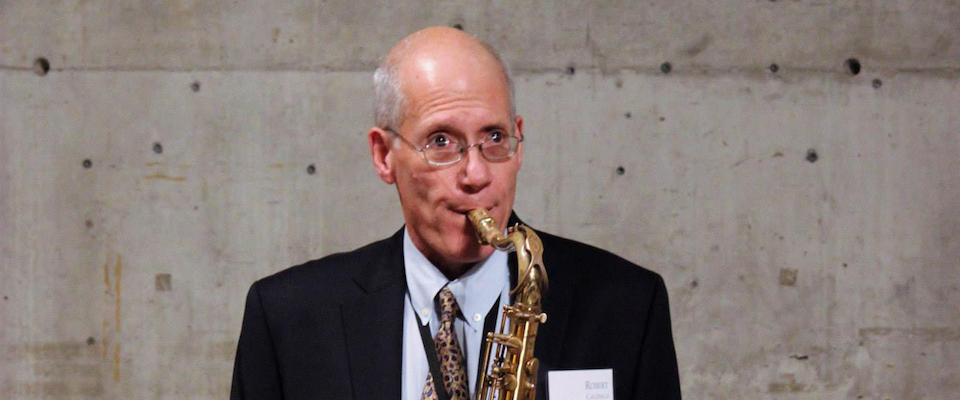They may be poor, but the Cal Band is still the pride of California.
Down in the basement of Cesar Chavez Student Center, students are gearing up for rehearsal. Instrument cases cover the floor and balance atop lockers. In what looks like a modern art installation, mounted sousaphones snake up and down the far wall. Robert Calonico ’76 is at the podium. Clad in a dark sports coat and a navy blue sweater, the UC Berkeley Director of Bands is tall and thin, a few inches above 6 feet, with thin-rimmed glasses and a crown of gray hair horseshoeing his head. As he prepares to begin, a band member calls out from the doorway.
“Bob,” the student yells, then whistles to get his attention. “It’s gone. I checked the back room.”
“You owe me a bass clarinet,” Calonico shouts back.
“I don’t owe you anything,” the student squeaks in defense.
“Who did I give it to?”
“I didn’t, I didn’t—”
Calonico, who wields authority with a mix of self-deprecating humor and gentle ribbing, mocks the nervous stammer, until the student offers up someone he can call who might know the instrument’s whereabouts.
“He’s in New York doing an audition,” says Calonico, “I hope you reach him right when he’s on a downbeat to the Juilliard review.” The room fills with laughter. As band members come in and set up, here and there a clarinet or trumpet sings out practice notes over the conversation, which has turned now to Juilliard and the absent student.
“What, are we all taking the day off?” Calonico says.
One of the faces in the room is Thomas Gartner ’11, the Cal Band’s Student Director, or StuD (pronounced as if in reference to a thoroughbred). A scruffy-faced senior in shorts and a T-shirt, Gartner is more serious and mature than his appearance suggests. Asked his major, he responds, “I’m a chemical engineer,” as if he had already settled into a career and corner office.
One of the distinguishing characteristics of the University of California Marching Band is that it is almost exclusively student-run, led by an executive committee, or ExComm, composed of the Director of Bands (the only paid position) and five student officers: the Student Director, Drum Major, Senior Manager, Public Relations Director, and Executive Secretary. A web of subcommittees and instrument sections branch off from there. The full organizational chart is displayed on a poster board that hangs on a wall in Cesar Chavez. Unflattering nicknames accompany the cutout faces of committee members, which are pasted atop the buxom or brawny bodies of actors from Sex and the City and Baywatch. To an outsider, the overall impression is that being in the Band is a little like being the subject of a roast.
When Gartner, the StuD, talks about Band, though, he’s all business. “Some people are content just to be members. They do four years of marching, and they like that. But starting from your second year, there are things that you can do to get increasingly involved.” That’s an understatement by most standards. An informal survey showed that even rank-and-file members devote 18 hours a week to Band activities. Ex-Comm members typically log another 30 hours per week on top of that. Study time gets squeezed in somehow. In the lead-up to rehearsal, one young woman alternately practiced the piccolo and read from a macroeconomics text on the stand next to her sheet music.
One of the ExComm’s main tasks is selecting halftime shows. Six performances are culled from as many as 100 ideas submitted by members. The Drum Major then choreographs the selected routines using a computer program called CalChart, designed by former Band member Garrick Meeker ’96, which blocks individuals’ movements on the gridiron in a dizzying cipher of acronyms and numbers. Over the years, the Band’s halftime performances have run the gamut from The Beatles to Lady Gaga.
The gridiron is the Band’s most visible venue, but hardly its only one. The Marching Band (including the Straw Hat Band, its traveling component) plays roughly 150 events a season, including 50 or so during Big Game week alone.
At the Big Sail, the annual sailing race between Cal and Stanford, the Straw Hat Band faces off against Stanford’s notoriously raucous squad at the St. Francis Yacht Club. Last year’s battle of the bands took place on a pleasantly warm day in November. Stanford red filled one side of the club, Cal blue and gold the other, and each side had its own catered buffet and wine bar. When I asked a young piccolo player who was winning the race, she said, “I have no idea. But I’ve never felt more WASP-y in my life.”
As with most such gigs, the Band played for free, but donations, as always, were “highly encouraged.”
Unlike most university marching bands, the Cal Band is not part of either the music or athletic departments, and in fact receives just $20,000 from Cal Athletics, out of a total annual budget of $550,000. Instead, the Band is part of Student Musical Activities, which is, in turn, administered by Cal Performances. Additional funds come from student registration fees and endowment revenue, but when all is said and done, the Band still has to raise some $250,000 a year.
In truth, money has been an issue for the Band since its beginnings as the Cadet Band, when enterprising students of the 1870s solicited $25 apiece from regents and professors in order to buy instruments. At one point in the mid-1960s, the ASUC, under whose aegis the Band operated at the time, cut its funding by half in a single year. The reason? Berkeley had become increasingly hostile to anything remotely suggesting military, and since all marching bands came out of an ROTC tradition, the ASUC decided to hit the Band where it hurt, right in its coffers.
In the last several years, not only has the Band had to do more fundraising, but individual members have had to cover as much as two-thirds of the cost of travel to away games. Not that Band members are balking, necessarily. According to Calonico, there are always members who are willing to dig into their own pockets to hit the road. “It just seems wrong that they have to pay,” he said. “And no other spirit groups have to pay. There’s Oski, there’s Rally Committee, and there’s the dance team. They are funded through Athletics.”
The fiscal reality has kept the Band at home on occasion, as in the first away game of 2008, when Cal met Washington State in Pullman. In the opening play of that game, Jahvid Best ran 80 yards for a Bears touchdown, a feat that should have been punctuated by a rousing rendition of “Fight for California.” Instead that TD and each scoring drive that followed (the final tally was 66–3, Cal) was met with relative silence. The lack of fanfare was so conspicuous that Joe Starkey, who called the game for KGO, was moved to inquire on-air as to the Band’s whereabouts.
It was the first game the Band, the “Pride of California,” had missed in more than a decade, but it wasn’t the last; in the past three seasons, the Band has missed five away games. Calonico says the hardest part of the decision to forgo road trips is telling the students. “We’re supposed to be the bringers of the California Spirit, and they buy into that. It means a lot to them.”
While most fans will be surprised to learn that Band members foot much of the bill for some road trips, it’s no secret around campus that the Band is underfunded. As part of a 2007 referendum, the Vice Chancellor of Administration’s office examined the Band’s budget and found an unmet need of roughly $180,000 per annum. The referendum also looked at other Pac-10 universities’ contributions to their respective marching bands, many of which have paid positions for students. At the high end of institutional support was UCLA, which invested more than $260,000 in its band. On the low end was Cal, where the figure was pegged at a paltry $25,000. The band with the next-lowest funding, Arizona, received almost four times as much. Despite the disparities, the student body failed to pass the referendum, which would have given Student Musical Activities an additional $150,000.
Amid campuswide (and statewide) economic woes, the question arises: Should Band members be awarded some other kind of incentive for their sacrifice—course credit, perhaps? Most Band members I spoke with shuddered at the idea. For his part, Gartner allowed that incentives would “be really nice,” but added, “The culture of the Band is such that we do it because we love it, and we think it’s a lot of fun.”
Calonico is more dismissive: “The students don’t want credit, they don’t want pay. I think that if you start doing that you start getting people in the Band who are there for another reason as opposed to really supporting the school.
“You can’t pretend to be enthused,” Calonico continued. “You either are or you’re not. I think our group is kind of unique in that way. I’ve seen so many college bands, and a lot of them look like they’re on their way to a funeral or something. It’s a special group of students that really love it.”
Indeed, the enthusiasm among Cal Band members borders on zeal, and the bonds of fellowship are forged early. Every year, incoming Band members, or “newmen,” as they are called, are initiated by the “oldmen” of the Band. While singing “All Hail” or “Big C” the novitiates are led up into the rugged Eastern foothills by their wiser, more experienced cohorts, to the place where the University’s symbol stands clear and bold. Only the C isn’t its customary hue. The vile Cardinal has struck (or so the newmen are told), and it’s up to them to right the wrong. The whole Band, including Calonico, is there with buckets of gold paint, cheering the newmen on. The only thing lacking is paint brushes; the Band members use their bare hands and clothed bodies to restore the C.
It’s more than just the symbol that gets refreshed. This and other rituals, most of them closely guarded secrets, are a big part of what knits the Band—an ever-changing group of 240 students—into a tightly woven community. And that is what the Band is finally all about: music, yes, but to an even greater degree, friendship and the Spirit of Cal.
Back in 45 Cesar Chavez, Calonico utters a sharp “OK,” and the musicians are hushed and ready to roll. He sways back and forth as he conducts, his hands dancing up and down, side to side. He interrupts the flow of music from time to time, saying the “textures are thin” here, and “I would put more aggressiveness in your sound” there. At one point he tells the students he can hear their lack of security.
They’re working on a composition called “Impressions for Band,” written by Michael Senturia, Calonico’s mentor from the Department of Music.
“Here we go. Big breath,” Calonico says, and they start again.




















